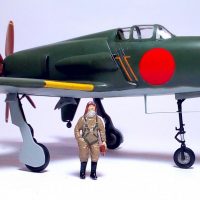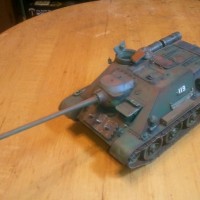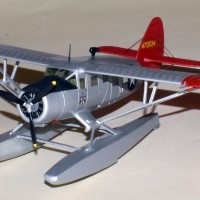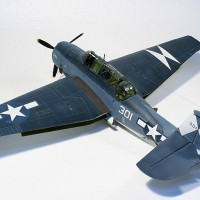Camouflage & Markings: RAE S.E.5a
Entering service with the Royal Flying Corps (RFC) in 1917, the S.E.5a quickly proved to be one of the most effective fighters of the war. It was initially powered by a 200 hp Hispano-Suiza engine, which was later replaced by the Wolseley Viper. It proved to combine a stable gun platform with impressive speed and maneuverability. These qualities made it a favorite among pilots, including notable aces such as Albert Ball and Edward Mannock. Its combination of speed, firepower, and reliability played a crucial role in achieving air superiority during the concluding phase of the Great War.
The dark green color universally used on the RAE S.E.5a was commonly referred to as “PC10” (Protective Covering 10). Earlier during the war, the British Royal Flying Corps (RFC) began experimenting with various camouflage schemes to reduce the visibility of their aircraft. PC10 emerged as a practical solution due to its dark, olive-green shade, which provided effective concealment against the ground when viewed from above and blended reasonably well with the sky when viewed from below. As was the practice of the day, the color was a mix of pigments, including iron oxide and lamp black, which resulted in its distinctive hue. The actual paint was often blended on-site.
Consequently, this episode of "Camouflage & Markings" is really only about the markings, everything else being just the same paint scheme!
The color profiles were researched and drawn by Mr. Rick Kent, a former librarian and curator at the RAF Museum in Hendon. Used here with kind permission of the author.
Gilbert Insall joined the RFC as a 2nd Lieutenant in 1915, and was assigned to No. 11 Squadron. He was awarded the Victoria Cross for salvaging his Vickers FB.5 Gunbus on November 7, 1915. However, he couldn't claim it until September 27, 1917, after escaping captivity following his shoot-down on December 14, 1915. Upon returning to service, he led Flight A in No. 50 Squadron. Insall continued as a military pilot until 1945. He passed away on February 17, 1972, and his Victoria Cross is now in the RAF Museum in Hendon. The white parts of the national markings on the upper wings, the fuselage and the rudder were overpainted with camouflage for night fighter missions.
No. 40 Squadron switched to the excellent S.E.5a in October 1917. Here, one of its aces, Capt Gwylym Lewis' mount designated D3540/K.
Lewis was assigned to 40 Squadron to train as a flight commander on S.E.5as. He began his training duties in September 1917. On 19 December 1917, he drove an Albatros D.III down out of control. He would drive another down a month later, on 19 January 1918. He would score nine more times in the next six months, including one triumph shared with his squadron leader, Major Stan Dallas. Lewis ran his personal tally to five German planes destroyed, six driven down out of control, as well as capturing an LVG reconnaissance plane on 7 July 1918 for his final win. He was awarded a DFC.
In 1917, No. 41 Squadron were leaving their obsolete F.E.8 to covert to a newer fighter type. They were initially re-equipped with DH 5 fighters, which proved very disappointing; in October 1917, the squadron finally received S.E.5a fighters, with which they were equipped for the duration of the war.
The squadron provided distinguished service in the Battle of Cambrai (November 1917), and subsequently in the German spring offensive (March 1918), and the Battle of Amiens (August 1918). 41 Squadron claimed its final victory of the war two days prior to the cessation of hostilities.
A long-standing user of Nieuport fighters, No. 29 Squadron flew Nieuport Scouts longer than any other RFC squadron before receiving the S.E.5a in April 1918.
The story of No. 74 Squadron, also called 'Tiger' Squadron is truly remarkable. The squadron's first operational fighters were S.E.5as, received in March 1918. The squadron served in France from April until February 1919, when it returned to Britain where it was disbanded on 3 July 1919.
During this short wartime service, the squadron was credited with 140 enemy planes destroyed and 85 driven down out of control, amounting to 225 victories in total. Seventeen aces had served in the squadron, including Victoria Cross winner Major Edward Mannock, Ira "Taffy" Jones, Benjamin Roxburgh-Smith, future Air Commodore Keith Caldwell, Andrew Kiddie, Frederick Stanley Gordon, Sydney Carlin, Frederick Hunt, Clive Glynn, George Hicks, Wilfred Ernest Young, Henry Dolan, Harris Clements, George Gauld, and Frederick Luff.
This particular machine belonged to one of the less fortunate pilots of the squadron, Lieutenant Philip James 'Poet' Stuart-Smith. On 8th May 1918, it was last seen in a dogfight with 10 enemy aircraft, east of Zillebeke, near Ypres, Belgium. His remains were never found.
For the remaining profiles, click on the thumbnails below.












Thanks a lot for sharing, Martin @editor
Very interesting.
Thank you!
Fantastic article, Martin! Thanks for sharing!
Glad that these profiles are appreciated. Cheers
Some good information on a great old aircraft, thanks for sharing.